
- +86 130 8806 0987
- sales_02@fly-bee.com
FAQ
Q:How do I choose between chemical acaricides and organic acids for Varroa treatment?
The choice depends on your priorities:
Chemical acaricides (e.g., pyrethroids like fluvalinate): Opt for these if rapid mite knockdown is critical (e.g., pre-winter preparation), offering >95% efficacy within 48 hours.
Organic acids (e.g., formic/oxalic acid): Ideal for honey flow periods or organic-certified operations, ensuring <0.01ppm residue levels but requiring 3-5x higher dosage and biweekly applications.
Q:Why is alternating between chemical and organic treatments recommended?
Alternation (e.g., pyrethroids in fall + organic acids in winter) minimizes:
Resistance risk: Prevents mites from developing P450 monooxygenase-mediated resistance.
Residue buildup: Reduces chemical accumulation in wax (pyrethroids persist up to 8 weeks).
Operational costs: Balances the higher expense of organic acids with cheaper chemical interventions.
Q:How do I choose between chemical acaricides and organic acids for Varroa treatment?
The choice depends on your priorities:
Chemical acaricides (e.g., pyrethroids like fluvalinate): Opt for these if rapid mite knockdown is critical (e.g., pre-winter preparation), offering >95% efficacy within 48 hours.
Organic acids (e.g., formic/oxalic acid): Ideal for honey flow periods or organic-certified operations, ensuring <0.01ppm residue levels but requiring 3-5x higher dosage and biweekly applications.
Q:Why is alternating between chemical and organic treatments recommended?
Alternation (e.g., pyrethroids in fall + organic acids in winter) minimizes:
Resistance risk: Prevents mites from developing P450 monooxygenase-mediated resistance.
Residue buildup: Reduces chemical accumulation in wax (pyrethroids persist up to 8 weeks).
Operational costs: Balances the higher expense of organic acids with cheaper chemical interventions.
Q:Can I apply treatments during honey harvesting or honey nectar flow period?
Organic acids: Safe to use up to 48 hours before harvest (EU EC 834/2007 compliant);
Chemical acaricides: Require a 6-8 week withdrawal period; avoid during active honey flows.
